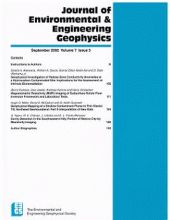Zarif et al., 2017
Recommendations for field-scale induced polarization (IP) data acquisition and interpretation
Zarif, F., Kessouri, P., and Slater, L (2017)
Journal of Environmental and Engineering Geophysics 22 (4): 395-410
Abstract
Field-scale induced polarization (IP) data remain underutilized due to the challenges of data acquisition and interpretation of the resulting observations for near surface environmental applications. We use measurements at a test site and the principle of IP reciprocity to demonstrate that the primary factor controlling the quality of IP data acquired using standard resistivity/IP imaging systems is the signal to noise ratio (SNR), i.e., the recorded signal strength. This factor favors the use of nested arrays, where one or two of the potential electrodes fall between the current electrode pair, that guarantee a high primary voltage (Vp) versus Dipole-Dipole type arrays where voltage differences rapidly decay away from the current injection pair. Comparison of data acquired using stainless steel, Cu-CuSO4 porous pot and graphite electrodes demonstrates that electrode material is a significant second order factor but only for measurements where the SNR is relatively low (for the instrument used in this study when Vp < 30 mV). We also propose a simple framework for interpretation of environmental IP datasets whereby the acquisition of IP data is used to remove the inherent ambiguity in the interpretation of standalone resistivity data such that the subsurface distribution of the surface conductivity and electrolytic conductivity contributions to the total conductivity can be resolved. We demonstrate this approach on a field site within a first order catchment where a high surface area formation likely limits vertical transport and promotes interflow. Sharp contrasts in electrical structure between the two slopes of the catchment are observed.
Citation
Zarif, F., Kessouri, P., and Slater, L (2017): Recommendations for field-scale induced polarization (IP) data acquisition and interpretation. Journal of Environmental and Engineering Geophysics 22 (4): 395-410. DOI: 10.2113/JEEG22.4.395
 This Paper/Book acknowledges NSF CZO grant support.
This Paper/Book acknowledges NSF CZO grant support.
Explore Further

